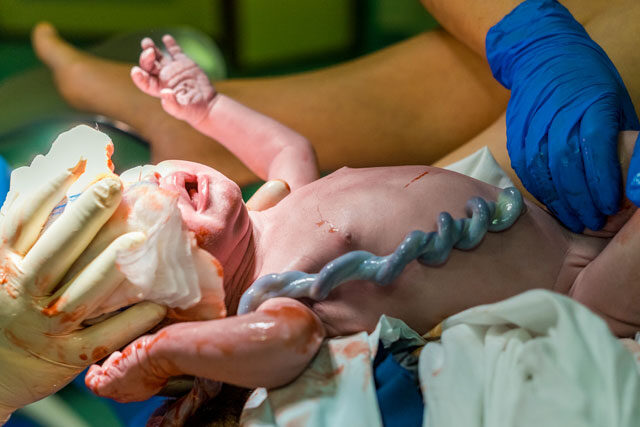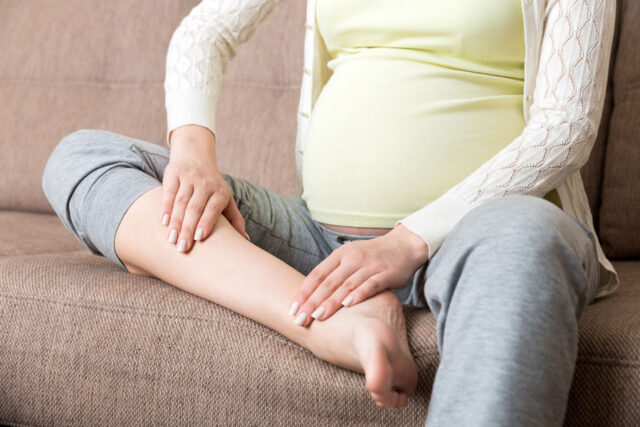Every father accompanying his wife in labor feels thrilled when a doctor offers to cut the umbilical cord. This organ is somehow sacred, which is often explained by the fact that it is the thing that joins the mother and her baby not in the emotional sense but physically.
The umbilical cord is an organ in the fetus which delivers nutrient-rich blood and oxygen to the baby and carries away the waste products. It is attached to the placenta and contains two arteries and one vein. The umbilical blood vessels go through the umbilical cord covered with Wharton’s jelly. The latter performs a protective function and works as insulation for the blood vessels.
Who Has an Umbilical Cord?
The formation of the baby’s umbilical cord starts in the embryonic period (around three weeks gestation). By the end of week seven, this organ is fully formed, providing nutrition for healthy fetal development and growth.

Throughout pregnancy, the umbilical cord plays an essential role in supporting your baby’s life. Once the baby is born, it doesn’t need it anymore. Therefore, only unborn and newborn babies have an umbilical cord. Still, every child and adult has a kind of reminder about times when they had an umbilical cord – their belly button.
How Long Does the Cord Stay Attached?
Once you deliver your baby, your provider will clamp and cut the umbilical cord, forming a stump. Based on the WHO recommendations, this should be done not sooner than one minute after the baby is born.
The British Royal College of Obstetricians and Gynecologists recommends a two-minute wait before clamping the cord. The American College of Obstetricians and Gynecologists recommends waiting 30 – 60 seconds before clamping the cord. However, the current situation in most US hospitals is totally different. The cord is cut 10 – 15 seconds after birth.
A delayed umbilical cord clamping has multiple benefits, so you may ask your OB-GYN to wait for some minutes or until pulsation in the cord stops.
After the cord separation, the umbilical cord stump gradually dries up. It may take one to three weeks before it dries and falls off. During all this time, parents should take care of the stump, keeping it safe from infection and other complications.
Take Care of an Umbilical Cord
Umbilical cord care doesn’t require a lot of time or knowledge. Besides, hospital staff will instruct every parent on how to do this at home, so no reason to worry. The essential care is to keep the stump dry and clean so that it doesn’t get infected. Here’s what you should do:
- Never use any alcohol-containing topical substances to speed up the stump dry. Air drying is the only safe way to do this.
- Be careful when diapering your newborn. It’s essential to fold the diaper below the stump. This way, it stays in contact with the air and doesn’t get injured by accident.
- Bathing your baby before the umbilical cord falls off is not recommended. Use sponge bathing instead. If there’s a need, you can gently wipe the area around the stump with plain water.
- Never pull off the cord. It has to fall off naturally without your assistance, even if it seems like hanging by the thread. By pulling it, you risk provoking umbilical cord bleeding, which is the last thing you want with the newborn.
- Examine the stump for signs of infection regularly. The earlier you notice something is wrong and seek medical assistance, the less harm the infection will do.
How to Tell if the Cord Is Infected?
If you think that you might not differentiate between a normal vs. an infected umbilical cord, don’t worry about that. The infected umbilical cord looks very specific, so there’s no way you can confuse it. Here’s what you may see if the umbilical cord is infected:
- Skin color changes. The skin around your stump may get red and swollen.
- Pus or fluid leaking from the stump. It is usually yellowish in color and has a specific bad smell.
- Changes in the baby’s behavior. Your newborn may be overly sleepy.
- Fever is another sign of infection. It may go to 38° (100.4° F) or higher.
- Hypotonia, which is weak muscle tone, may signal infection.
- The baby refuses to eat or eats less than they are expected to.
Whenever you notice some of these symptoms, call the baby’s provider. You’ll have to go and see your doctor for the newborn to get treatment. At such a young age, the infection can spread lightning-fast, so you should keep a close eye on your baby’s umbilical cord.
What Happens after the Birth?

When your baby has been delivered safely, the cord that connects them with the placenta is clamped and cut. For a few days that you stay in a hospital, the medical staff will explain how to take care of the cord stump. Once you are released home, this becomes your responsibility to take care of the stump and make sure no infection appears at the sight.
After some time, the cord will dry out and fall off, which means your baby’s cord has healed well.
Benefits and Risks
The umbilical cord falling off is a natural process, which is essential for the baby’s health. Taking care of the umbilical cord stump, you ensure no infection affects your baby in the very first weeks of its life.
Still, there remain some risks that you should be aware of. Aside from the infection, the umbilical cord healing process may be exacerbated by other medical conditions requiring medical help. They are:
- Umbilical granuloma. The incidence of this condition is 1 in 500 under some evaluations. You may know that your baby has an umbilical granuloma by a small bump of tissue, which appears to be scar tissue of a reddish color. In some babies, it may leak with clear or yellowish fluid for up to a week. If the leakage doesn’t stop, seek medical assistance.
- Umbilical hernia is another complication you may face. It looks like a bump under the belly button. This is a defect in your baby’s abdominal wall, which lets some parts of the intestines bump out. Typically, an umbilical hernia resolves on its own before 18 months. If it doesn’t, your child will have to undergo surgery at 5 years old or later.
Recovering
After the cord dries off, you can start bathing your baby in a bath with no risk of infection getting through the stump. If the belly button looks healthy (no redness, no swelling, no leakage), you shouldn’t worry about that any longer.
But if something about your baby’s belly button bothers you, contact the healthcare provider for advice.
Summary
The baby’s umbilical cord is something you’ll have to deal with in the first weeks of your baby’s life. Nevertheless, you should be well informed about how to take care of it, as your child’s health depends on your knowledge and responsibility.
FAQ
When Does Umbilical Cord Fall of?
It may fall off anywhere from one to three weeks after your baby is born. Usually, it takes around 7 – 10 days.
What Is an Umbilical Granuloma?
It’s a scar tissue that forms under the cord stump, so it becomes visible on the belly button once the cord falls off. It is usually moist, red, and looks dangerous, but it is a minor problem that typically resolves on its own.
What to Do When Umbilical Cord Falls off?
Check if your baby’s belly button looks healthy. Look for a change of color, bleeding, or other disturbing things. If it looks fine, then you have nothing to worry about.
How to Clean Umbilical Cord?
You don’t need to clean the umbilical cord itself, but you may wipe with a wet sponge the area around it. Use plain water only.




